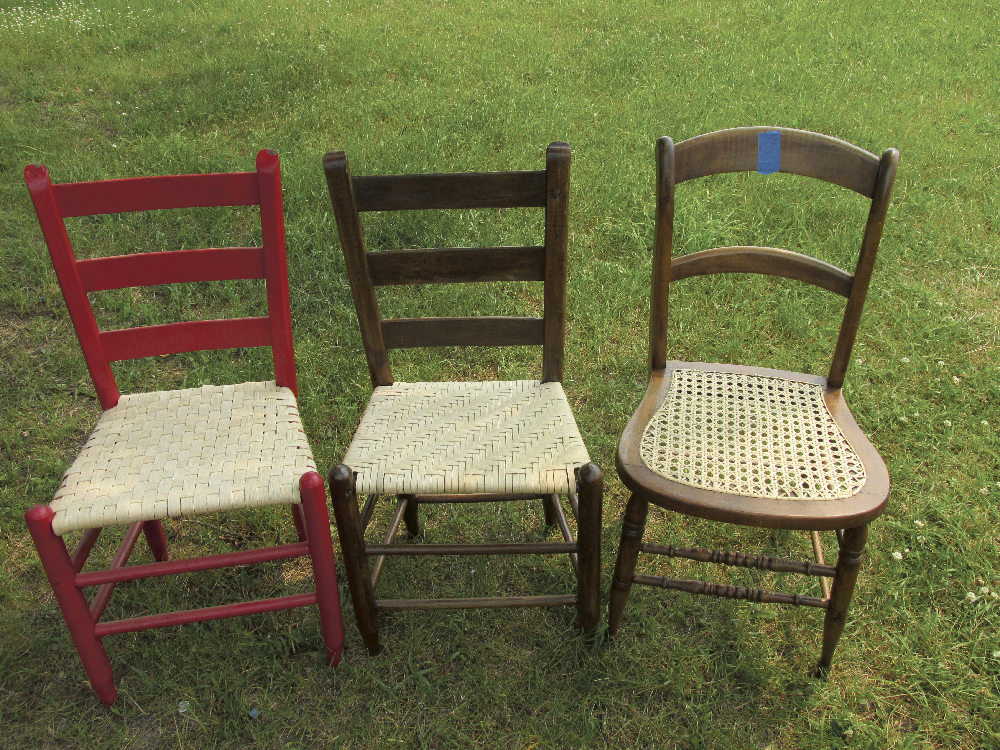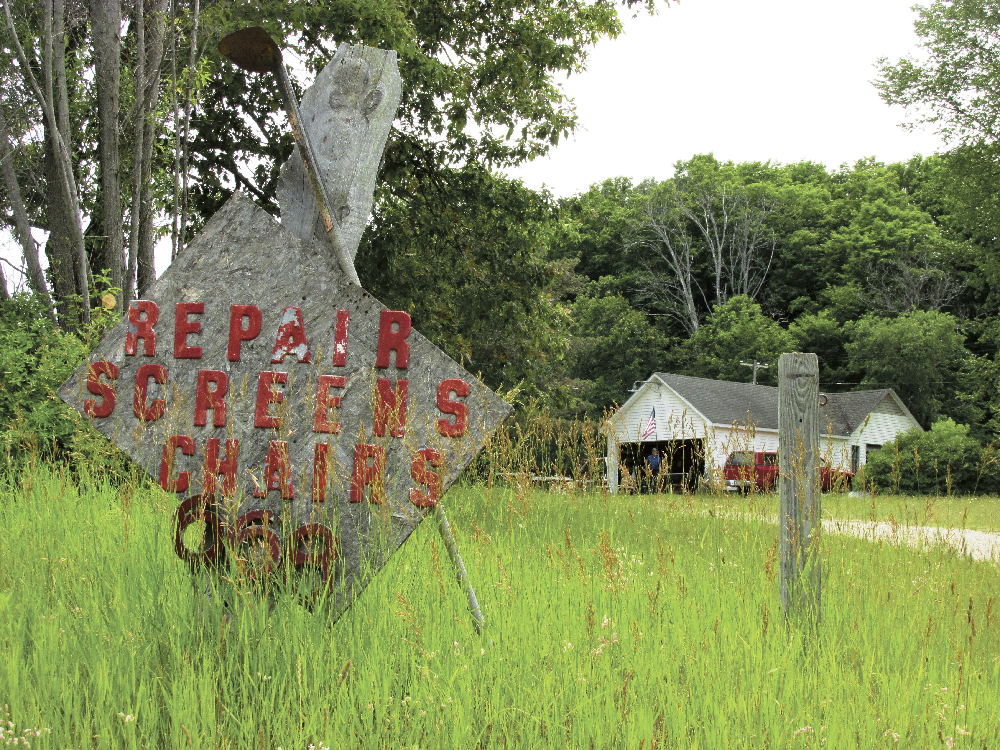Mr. Joy’s 31 years of making things better
He can’t be reached by phone. To find him, you drive out Commercial Avenue/Case Road from the center of downtown Beulah and look for a garage up to the right at the corner of Richards Road, which looks like nothing more than a dirt driveway. Back in the day, you could check on whether he was available by calling Mr. Ed’s Hardware, located across the road: someone would look out the window and report back yes or no. But Mr. Ed’s closed years ago, though the sign is still on the building.
However, Mr. Doug Joy—tall, erect, twinkly, articulate—has never stopped working. He makes broken things better every day, and he loves his work.
He canes chairs, benches, and canoe seats; repairs furniture; builds and repairs screens. News to me: he also makes elaborate large puzzles out of metal and wood.
I found him from an ad in the classifieds years ago, when he made six screens for our rudimentary cabin, a huge improvement over the slidey-screen inserts—he changed our lives!
Joy learned to weave cane and install pre-woven cane webbing from Hugh Moss, of Crystal Crafts, in the early 1980s. Joy had retired from the frozen foods division of Pet Milk.
“I got tired of working at 62”, he says, so he decided to “grow a garden and do something.”
Moss took him on as a kind of apprentice, and, by 1984, he had caned enough chairs to know the trade. He’s been caning ever since. He just turned 94.
Before his career in frozen foods, Joy served 37 months as an Army medic during World War II in the Pacific—he has a map showing his unit’s route from San Francisco to Guadalcanal, Palau, New Caledonia, and Japan.


In that first youthful job, he repaired wounded soldiers and helped make them whole again. Now, he repairs broken chairs and makes them beautiful.
Joy will cane ladderback chair seats; carved antique chairs with caned panels in the seat, back, and sides; wicker chairs; whole sets of dining chairs; canoe seats—“whatever comes along that needs cane, I cane.” He keeps a photo album with samples of some of his most interesting projects, and he estimates that he has caned more than 200 chairs by now. He has never advertised his caning business, besides occasionally in the classifieds section—it’s all by word of mouth among members of a growing “cultivated clientele.”
Joy’s hand-woven cane follows various patterns of ups and overs. There’s the simple lattice pattern, such as you would see on a cherry pie, but less open. A variation is the herringbone pattern, producing overall diagonals. I’ve seen him hand weave a hexagonal openweave. All of these use flat cane and are strong enough for the seats of wide benches. Another technique uses narrow, round cane that is woven from four sides to meet in the center in four thick triangles.
These and other woven styles are options when the frame includes holes along the sides for anchoring the cane. However, when it doesn’t, Joy uses sheets of pre-woven pressed cane webbing, held in place with narrow splines that are pressed into grooves around the edges. In these cases—especially tricky when the rectangular sheets must conform to a curved opening—the sheet is installed oversized and then trimmed when finished.
Joy prefers weaving to using pre-woven webbing. He says that installing pre-woven pressed cane is like repairing a window screen, producing good and predictable results without offering a special challenge. But every job is an accomplishment, ultimately, with a satisfying end product.
So, his biggest challenge? Joy has a photo of one wide chair whose back and seat are one continuous caned surface—60 inches from top to front edge—done with a single strand of common cane. This job had to be employed perfectly, from beginning to end, as splicing wasn’t possible; just one error, and he would have had to start over. That project took a week, and he says, “I was so glad to get that done!”
Another large project—completely re-weaving an antique wicker chair—took even longer. By one measure, the biggest project was to re-cane an entire set of dining chairs.
Special opportunities show up, also. He worked on a highboy that had broken apart after falling off a truck, and he has repaired a spinning wheel, too.
Any mistakes? Once, when trying to flatten a warped sheet of pressed cane, he branded the shape of the flat iron onto the area that became the front of the seat. He says that he stained the whole seat, so the customer never knew.
The sad fact is that sometimes the customer has no idea of how unique a piece is—for instance, the beautiful, all-one-piece caning job was on “just an old chair” that someone brought in from the now-gone Smokestack re-sale barn of Frankfort. Additionally, he still has a carved antique oak side chair that was owned by “a woman in Texas” (he doesn’t have her name) and “delivered by the Habitat guy”—it’s finished and fabulous, but she hasn’t come to claim it.
It’s common for him to charge “by the front inch” of a caning area (he currently charges about $4 per front inch) or on a per-hole basis ($1 per hole, sometimes more),when applicable. He’ll do an estimate if asked, and usually he comes in pretty close to it.
Joy says “my fingers are getting sore,” and so now he is assisted by his son, Jimmy—a graduate of the Benzie Central High School just after it was built—who has worked with his dad for years and by now “has done it all.”
If you go by the garage, you’ll see them working or sitting and chatting together; I visit the chair repairman of Beulah every summer. One day, we all just sat in the shade watching the thermometer on the tree climb into the 90s.
When I ask Mr. Joy if he has advice for anyone who is considering this trade, he immediately replies, “ Cultivate your patience!”
Feature photo: Doug Joy is so much more than a 94-year-old chair repairman in Beulah. Photo courtesy of Beau Vallance.





So proud of Gramp! His patience, skill and energy have been passed down through the generations of our Family. Just don’t try to beat him at Cribbage!!
He’s also known around town as Grampa Doug to many young people that he and his wife, Helen, helped to raise, as their baby sitters. He’s the greatest!